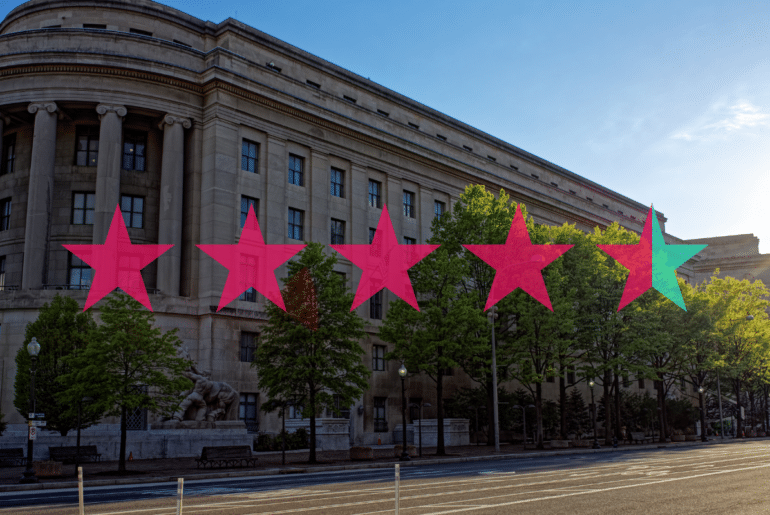Social media gives consumers the power to spread information to hundreds – if not thousands – of people in seconds.
For the restaurant industry, which relies heavily on reviews and recommendations, this means every customer now has the power of an acclaimed food critic – if not more.
- Instagram, TikTok, blogs, and other social sharing platforms allow everyone to be a “foodie.” Publicists no longer control the reputation of a restaurant or the food narrative – customers do.
- Due to the rise in social sharing over the last decade, restaurants must be proactive when it comes to developing strategies that protect their reputations.
- To design great strategies that will help your business survive and thrive, you have to understand how your audience views you through the lens of social platforms.
Here are three ways social media impacts the restaurant industry – along with tips for restaurateurs to adapt to social sharing.
1. High-Quality Photos and Videos Can Be Shared Easily Across Social Platforms
Pictures and videos posted by Instagram users can easily be shared across other high-traffic social networks, such as Facebook, Yelp, TripAdvisor, and Twitter. Not only that, but the technology powering a phone camera has evolved rapidly over the years.
In 2012, one of the most popular phones on the market (the Samsung Galaxy S III) only had an 8-megapixel rear camera. Its modern counterpart today (the Samsung Galaxy S22) comes with an ultra-wide camera, scene optimizers, and three different rear cameras ranging from 50 megapixels to 10 megapixels.
For additional context, Instagram had only 50 million users in 2012 – and TikTok didn’t even exist yet.
Social Sharing Is the Norm
What does this mean for restaurateurs existing (or wanting to exist) in the social spotlight?
- If your dishes look beautiful, phone cameras and social media filters have been optimized to make them look even more appealing when shared online.
- Think of this like free publicity for your restaurant – but it relies on excellent plating technique from square one.
- If you have a dish that happens to taste amazing but isn’t share-worthy, it may not get the exposure it otherwise deserves.
- Alternatively, if you have a dish that looks terrible and tastes terrible, people are going to find out about it quickly – and visibly.
Photos or videos of your restaurant aren’t just limited to reviews of food, either: A quick Google search for “restaurant fails compilation” yields about 3.5 million results.
How Restaurants Can Adapt
While text reviews are still the powerhouse driving Google Maps and Yelp, new research from 2022 on photos in reviews indicates that process-focused (think “experience-based”) food photos and videos directly impact purchase intention.
The reasons why a consumer may share pics or video reviews of their niçoise salad online are many, but on social media, it includes the need to feel validated about their purchase by a community that shares the same interests or to gain their own following.
Food has been used for social bonding for a long time – today it’s really no different. Instead of gathering around the dinner table, people are increasingly turning to social media to build those connections.
If you want to tap into this need for a community and help your food be the star of the show, you need to make plating, sanitation, and dining experiences a priority in 2023.
- Regardless of the type of cuisine, chefs need to create photogenic dishes that are attractive, colorful, and worth sharing.
- Plating technique should extend beyond what’s provided at the establishment: artistic touches to take-out meals will appeal to diners ordering delivery.
- Update your content gallery: Beautiful snaps or video clips of available dishes (with the name of the dish) can inspire visits and purchases – especially if this content matches up with what diners are sharing about you online.
- The last thing you want is to end up as an embarrassment due to poor hygiene practices, staff behavior, or other blunders that can be captured on video. Avoid a crisis that can spread quickly through social channels by making cleanliness and your company’s image a priority for everyone, from your front-of-house staff to the executive level.
2. Social Media Networks Are Used as Credible Sources for Reviews
Consumers turn to social media to find out information about restaurants they’re interested in – including reviews from past customers.
It’s not just limited to Google Maps and Yelp anymore, either: for example, Facebook has a review feature built right into their interface. If you have one, potential customers can look at reviews for your restaurant on your Facebook page without ever having to leave the website.
Outside of the traditional reviews you might find on a site like Facebook, restaurant owners also need to consider the impact of viral success (or failure) on sites like Instagram or TikTok.
If your restaurant:
- Appeals to a niche market in tone or character
- Outprices the competition or provides exceptional value
- Offers a product, meal, flavor, or experience other restaurants don’t
It’s entirely possible you may end up as the subject of a positive TikTok review without the involvement of your marketing team (if you have one). Viral TikTok reviews have also had an impact on which restaurants established food critics are willing to try as they capitalize on what’s trending to boost their own traffic.
Outside of viral success, restaurants can also grow their following organically on TikTok with a dedicated effort. There’s an opportunity present on TikTok to grow as a brand that no longer exists to the same degree on saturated sites like Instagram or Facebook.
Reviews Impact Purchases
Reviews have incredible power when it comes to a purchasing decision. Depending on whether the review is positive, negative, or neutral, a prospective diner can be motivated towards trying or avoiding different meals, deals, and restaurants. In fact, 94% of diners will research reviews about a particular restaurant before choosing to go.
There’s also a positive correlation between a restaurant’s social media reviews and their revenues – a one-star improvement in rating correlated to anywhere from a 5-9% increase in revenue.
It’s not just about the food, either: customers can just as easily be turned off by poor customer service practices. You’ll often see restaurants with reviews that mention how the food was great, but the service meant that they won’t be returning anytime soon.
How Restaurants Can Adapt
- Encourage customers to leave feedback – even if it isn’t always positive. While it’s never fun to receive a bad review, in some cases, it can be an opportunity.
- You might get some fake scathing reviews, but genuine negative feedback can be used to improve your restaurant in different areas, from the food you serve to the experience provided by your employees.
- Always respond appropriately to the reviews you get, regardless of platform. Whether it’s a review on Google Maps or Instagram, ignoring an issue can cause more fallout than the right response.
- Google goes so far as to say that businesses with a mix of positive and negative reviews also look more trustworthy.
Paying attention to reviews can benefit both the restaurant and the customer.
3. Social Media Is an Opportunity To Build Loyalty and Exposure, Regardless of Your Scale
If brands in a particular space want to maintain a competitive advantage, they need to pay attention to customer loyalty. This is especially true for restaurants – customers have more options than ever!
Loyalty programs are one way for restaurants to keep up brand interest and stand out from the competition. Luckily, social platforms allow you to nurture customer loyalty and create effective loyalty programs that keep customers coming back to your restaurant.
Customer Loyalty Can Drive Revenue
We live in an age where customer loyalty is everything – if a customer is loyal to a particular brand and it doesn’t happen to be yours, it can be difficult to get your product in front of them – let alone get them to buy it.
Social media – and TikTok, in particular – has completely shaken up this dynamic. Restaurants can quickly find themselves with a line of interested diners outside the door after going viral overnight. To keep that initial success from evaporating – and to reward existing customers – restaurateurs should adopt rewards systems that keep diners coming back for more.
Dining rewards and loyalty programs can also be a great way to encourage visitors to leave feedback, gather insights about your customers, and encourage business through slow seasons.
How Restaurants Can Adapt
There are several ways to structure a loyalty program or rewards system that benefits your fans.
- You can choose coupons, promos, or discounts as part of your rewards structure or consider points-based programs for certain actions, like ordering specials.
- Another option is with exclusive content, contests, or curated experiences for consumers and prospects who engage with your restaurant on social media.
- This encourages customers to spread your restaurant’s name across social networks by providing perks they actually want.
If you’ve ever seen a brand advertising giveaways on Instagram for followers that share their content by tagging friends or “battle of the burgers” style contests where diners help choose new flavors, you’ve seen reward-based marketing in action.
4. Social Media Is Used To Discover Information About Your Business
For smaller brands that don’t have the resources to invest in a website or app, social media can be a great way to spread information quickly about updated hours of operation due to changes in staff, new specials, holiday closures, hiring opportunities, and more.
Even for larger restaurants, it’s important to have information readily available on social platforms – some of your potential diners prefer using social to connect with you and your content.
Social Media Can Be a Valuable Tool
- Restaurants would be wise to hop on the mobile and social media bandwagon and cater to the convenience needs of their consumers.
- This allows you to control your brand messaging and image on social sites instead of your competitors.
- A majority of diners use their mobile devices to look up restaurant-related information and inform their dining decisions.
- If information about your restaurant isn’t easily available, customers will often move onto the next option – no matter how great your food or your service is.
How Restaurants Can Adapt
Thankfully, using your social media platforms to relay information about your restaurant isn’t difficult and can be a lifeline to your customer base. Just make sure you keep your social platforms updated with current information and respond to customers who reach out to you online.
Facebook has entire sections devoted to different types of information for businesses, including:
- Hours of operation
- Price ranges
- Ratings
- Types of service available (dine-in, take-out, delivery, etc.)
However, even outside of Facebook, you can always send out a quick message to let followers know you might be closing early that day or open later than you expected.
Sharing nutritional information, ingredients, menus, and specialty menus online is also a great way to reach out to consumers looking for their next favorite vegan dish or keto-friendly meal while searching for inspiration on their favorite social platforms.
Hungry for More?
Now that you know more about how diners are using social media and how to respond as a business, it’s time to put those insights into action. Leverage the tips we’ve included here for your restaurant, and you’ll be able to adapt into 2023 and beyond.
Interested in more?
Some statistics and links have been updated since this blog was originally posted in 2014 to reflect new information currently available in 2023.



